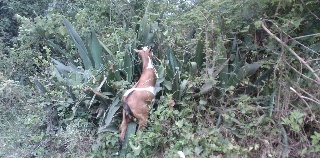Feeding habits of dairy goats
Knowledge of feeding habits of dairy goats or goats in general is important because it will help you determine feeding different categories of dairy goats
A goat does not like to graze on the ground like a sheep or cow. Goats like feeding at knee height up to head height. They like to feed above the ground often standing on their hind legs and resting their fore legs up on the bush or goat house wall.

Goats are browsers, choosy and sensitive to the kind of feed they take. They select for leaves and tender stems and can refuse up to 50% of feed offered.
They eat a lot of different plants/feeds. But they know what they want to eat. They prefer some plants/feeds to others. They even prefer different parts of the plant so they will eat leaves and flowers and not pods or stems, within the same plant.
Goats get bored when fed the same feed every day. They can be wasteful, only eating some of the plant. For example given un-chopped feeds like Napier grass they pull it out of the ground, eat the leaves only and do not eat the stem.
Goats are clean feeders, and will not eat dairy feeds which are not fresh or dirty e.g. Napier with mud splash from rain. They do not like sticky, mouldy, wet dusty feeds.
Goats need to be able to drink fresh water at all times.They ruminate more during the night than during the day as opposed to sheep which does it more during the day.
Goats are sensitive to poorly conserved feeds, concentrates, mineral mix etc. They cannot feed on open troughs, therefore if feeding is to be on troughs, the trough should have another design to avoid trampling, defecating on feeds etc. Hay should be put on hay rack.
Goats are poor users of artificial pastures – they waste about 50% of the pasture. Any disturbance for example rainfall will stop them from grazing. For good use of pasture restrict the animals using fences. Fences are moved everyday maintaining a high density of animals.
Grazing pattern is diurnal i.e. morning, evening and rest in the middle of the day. If temperatures are very high during the day the goats will graze throughout the night.
The main forage planted for goats include Napier grass, Lucerne, Rye grass, Red clover and Sudan grass
Feed intake is determined by
- Production capacity – the higher the production the higher the intake
- Physiological stage – During the first week of lactation intake may increase by 5%. Maximum feed intake is achieved 6 – 10 weeks
- Age – In the first and second years feed intake increases by 50%, but in the next 2 – 3 years intake increase by only 10%
- Breed – larger breeds have a higher intake. Takes at 6% live weight (3 kg DM per 100 Kg LW)
- Digestibility of feed – digestible feed increases intake.
- Availability – if feed is provided freely the more it is taken in.
- Palatability – goats prefer the more palatable feeds.
- Water intake – lack of water leads to reduced intake



